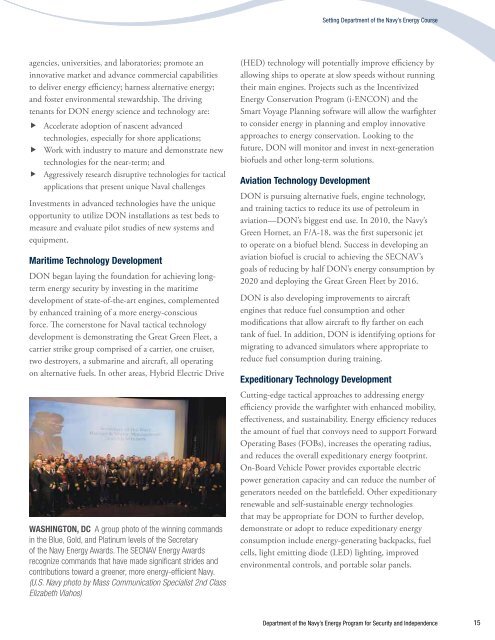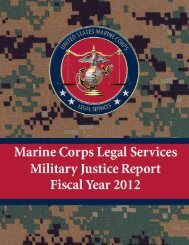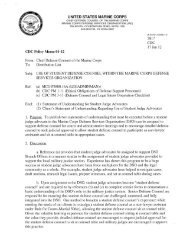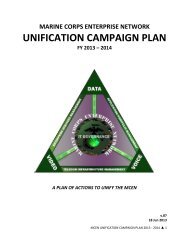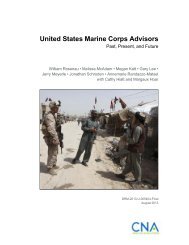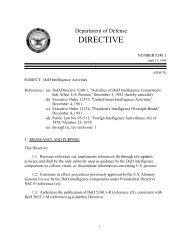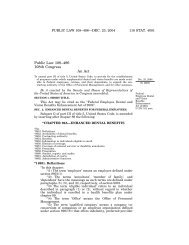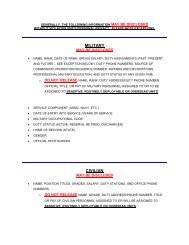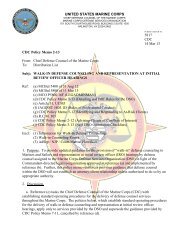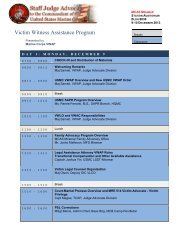Naval Energy Strategic Roadmap - US Department of the Navy ...
Naval Energy Strategic Roadmap - US Department of the Navy ...
Naval Energy Strategic Roadmap - US Department of the Navy ...
You also want an ePaper? Increase the reach of your titles
YUMPU automatically turns print PDFs into web optimized ePapers that Google loves.
Setting <strong>Department</strong> <strong>of</strong> <strong>the</strong> <strong>Navy</strong>’s <strong>Energy</strong> Course<br />
agencies, universities, and laboratories; promote an<br />
innovative market and advance commercial capabilities<br />
to deliver energy efficiency; harness alternative energy;<br />
and foster environmental stewardship. The driving<br />
tenants for DON energy science and technology are:<br />
ff<br />
Accelerate adoption <strong>of</strong> nascent advanced<br />
technologies, especially for shore applications;<br />
ff<br />
Work with industry to mature and demonstrate new<br />
technologies for <strong>the</strong> near-term; and<br />
ff<br />
Aggressively research disruptive technologies for tactical<br />
applications that present unique <strong>Naval</strong> challenges<br />
Investments in advanced technologies have <strong>the</strong> unique<br />
opportunity to utilize DON installations as test beds to<br />
measure and evaluate pilot studies <strong>of</strong> new systems and<br />
equipment.<br />
Maritime Technology Development<br />
DON began laying <strong>the</strong> foundation for achieving longterm<br />
energy security by investing in <strong>the</strong> maritime<br />
development <strong>of</strong> state-<strong>of</strong>-<strong>the</strong>-art engines, complemented<br />
by enhanced training <strong>of</strong> a more energy-conscious<br />
force. The cornerstone for <strong>Naval</strong> tactical technology<br />
development is demonstrating <strong>the</strong> Great Green Fleet, a<br />
carrier strike group comprised <strong>of</strong> a carrier, one cruiser,<br />
two destroyers, a submarine and aircraft, all operating<br />
on alternative fuels. In o<strong>the</strong>r areas, Hybrid Electric Drive<br />
WASHINGTON, DC A group photo <strong>of</strong> <strong>the</strong> winning commands<br />
in <strong>the</strong> Blue, Gold, and Platinum levels <strong>of</strong> <strong>the</strong> Secretary<br />
<strong>of</strong> <strong>the</strong> <strong>Navy</strong> <strong>Energy</strong> Awards. The SECNAV <strong>Energy</strong> Awards<br />
recognize commands that have made significant strides and<br />
contributions toward a greener, more energy-efficient <strong>Navy</strong>.<br />
(U.S. <strong>Navy</strong> photo by Mass Communication Specialist 2nd Class<br />
Elizabeth Vlahos)<br />
(HED) technology will potentially improve efficiency by<br />
allowing ships to operate at slow speeds without running<br />
<strong>the</strong>ir main engines. Projects such as <strong>the</strong> Incentivized<br />
<strong>Energy</strong> Conservation Program (i-ENCON) and <strong>the</strong><br />
Smart Voyage Planning s<strong>of</strong>tware will allow <strong>the</strong> warfighter<br />
to consider energy in planning and employ innovative<br />
approaches to energy conservation. Looking to <strong>the</strong><br />
future, DON will monitor and invest in next-generation<br />
bi<strong>of</strong>uels and o<strong>the</strong>r long-term solutions.<br />
Aviation Technology Development<br />
DON is pursuing alternative fuels, engine technology,<br />
and training tactics to reduce its use <strong>of</strong> petroleum in<br />
aviation—DON’s biggest end use. In 2010, <strong>the</strong> <strong>Navy</strong>’s<br />
Green Hornet, an F/A-18, was <strong>the</strong> first supersonic jet<br />
to operate on a bi<strong>of</strong>uel blend. Success in developing an<br />
aviation bi<strong>of</strong>uel is crucial to achieving <strong>the</strong> SECNAV’s<br />
goals <strong>of</strong> reducing by half DON’s energy consumption by<br />
2020 and deploying <strong>the</strong> Great Green Fleet by 2016.<br />
DON is also developing improvements to aircraft<br />
engines that reduce fuel consumption and o<strong>the</strong>r<br />
modifications that allow aircraft to fly far<strong>the</strong>r on each<br />
tank <strong>of</strong> fuel. In addition, DON is identifying options for<br />
migrating to advanced simulators where appropriate to<br />
reduce fuel consumption during training.<br />
Expeditionary Technology Development<br />
Cutting-edge tactical approaches to addressing energy<br />
efficiency provide <strong>the</strong> warfighter with enhanced mobility,<br />
effectiveness, and sustainability. <strong>Energy</strong> efficiency reduces<br />
<strong>the</strong> amount <strong>of</strong> fuel that convoys need to support Forward<br />
Operating Bases (FOBs), increases <strong>the</strong> operating radius,<br />
and reduces <strong>the</strong> overall expeditionary energy footprint.<br />
On-Board Vehicle Power provides exportable electric<br />
power generation capacity and can reduce <strong>the</strong> number <strong>of</strong><br />
generators needed on <strong>the</strong> battlefield. O<strong>the</strong>r expeditionary<br />
renewable and self-sustainable energy technologies<br />
that may be appropriate for DON to fur<strong>the</strong>r develop,<br />
demonstrate or adopt to reduce expeditionary energy<br />
consumption include energy-generating backpacks, fuel<br />
cells, light emitting diode (LED) lighting, improved<br />
environmental controls, and portable solar panels.<br />
<strong>Department</strong> <strong>of</strong> <strong>the</strong> <strong>Navy</strong>’s <strong>Energy</strong> Program for Security and Independence<br />
15


